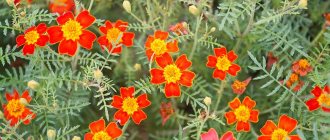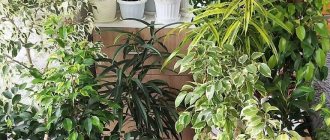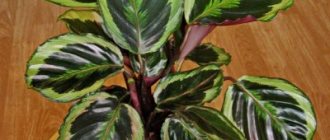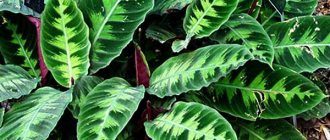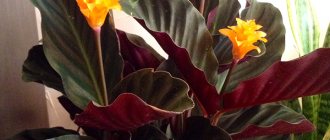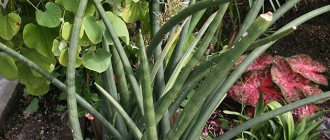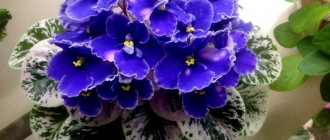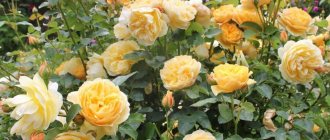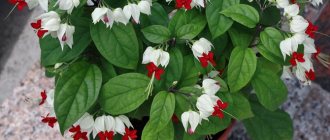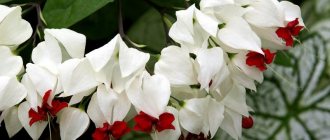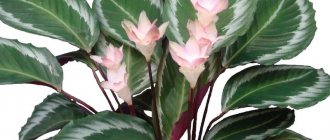Photo: inthi.ru Delicate, neat and graceful calathea has long become a regular guest of modern apartments and houses. Flower growers especially appreciate its large and showy leaves, the shape and color of which depend on the variety. It is impossible not to notice Calathea in the garden, store or greenhouse. And if you are already interested in the capricious South American guest, then we will tell you how to create ideal conditions for her in a green corner!
Calathea bachemiana
Currently, this type is one of the most popular. Its natural habitat is the tropical forests of Brazil. Calathea Bachema is distinguished by its unpretentiousness when compared with other representatives of the genus. In addition, it has quite bright decorative features.
It has lanceolate leaves, without a petiole. Reaches 35 cm in height. The width of the leaves is about 7-8 cm, and the length is 15-20 cm. Towards the top they narrow sharply. They have a dense leathery structure. The upper side of the leaf blade is light green, with a bright silvery tint. There is a dark green border along the edge of the plate. The underside is somewhat darker and monochromatic. A characteristic feature of the species is a pattern of dark spots or stripes running along the central vein.
Cream flowers are located on short pedicels, the length of which does not exceed 2.5 cm, and are collected in small, about 6 cm in length, spike-shaped inflorescences. After flowering, the plant often loses the entire above-ground part, but after a while new shoots appear. But in indoor conditions, Calathea Bachema practically does not bloom.
Calathea care
Calathea is quite demanding and capricious even compared to its tropical counterparts. But you can cope with it if you choose the right soil, fertilizers and observe the temperature and humidity conditions.
Temperature
Calathea prefers high and stable temperatures - about 20-25 degrees in summer. It is not recommended to lower it below 12-15 degrees even in winter, and this is with minimal watering. Avoid sudden changes, wind, drafts, radiators and other heat sources. Do not leave calathea on the walkway or on the windowsill near a window that is constantly opening.
Photo: fruit-grower.info
Lighting
The flower loves warmth and light, but too intense direct sunlight leads to burns. If there is not enough sun, the calathea loses color, withers, and the leaves curl and fall off. Ideal conditions are a semi-shaded corner of the room, which is also protected from drafts.
Photo: orchidea-shop.ru
Watering
In nature, the moisture-loving calathea feels best on the coast of islands and rivers, so carefully monitor the humidity and ensure regular watering. In summer, spray the flower with a small spray bottle - it’s neater and more delicate than a shower.
There is no need to spray only varieties with pubescent leaves - this will damage their texture. In this case, moisten the air around the calathea by shaking off dirt with a soft brush and occasionally bathe the flower.
For irrigation, use only clean, settled water and under no circumstances allow it to stagnate. Fill the stand with moss or pebbles and moisten it so as not to overfill the flowerpot and avoid rotting of the root system.
Photo: waysi.ru
Fertilizers and fertilizing
Calathea needs the regular introduction of specialized fertilizers with a complex of useful elements. During active growth, add additional calcium and nitrogen separately every couple of weeks. Intensive soil fertilization continues after flowering - minimize it gradually.
Photo: plantopedia.com
Trimming
Calathea is spectacular in its natural form, so it does not need regular pruning. But be sure to remove dry and damaged leaves, otherwise this often leads to infection or the development of fungus.
Photo: komnatnyecvety.ru
Calathea lubbersii
This species is native to the tropics of Central America. Calathea Lubbersa can grow up to 80 cm in height. The leaves are large (up to 30 cm in length), quite wide. They have an oval shape and are located on long petioles. Also a distinctive feature of Calathea Lubbers is the asymmetry of the pattern. The main color of the leaf blade is bright green, with large spots of light green or light yellow on it.
Calathea of this species also stands out among others by the color of the underside of the leaf. It has a green tint, while in most species the underside of the leaf is painted in red shades. Has a uniform color, without spots. Often slightly lighter than the upper side. At home it blooms extremely rarely. The flowers are orange in color.
Calathea lancifolia (Calathea lancifolia)
A popular species, characterized by rapid growth and relative unpretentiousness to living conditions. Natural habitat is tropical rainforests of Brazil.
The wonderful calathea reaches a height of up to 70 cm. The leaves are long and narrow, lanceolate. Their length rarely exceeds 25 cm. The width of the leaves is 3-5 cm. The edge of the leaf blade is slightly wavy.
Lanceolate calathea has bright decorative qualities. On top, the leaves are light green in color with a geometrically regular pattern of dark green ovals of small and large sizes, which alternate with each other. The underside of the leaf is dark burgundy, often mixed with a purple tint.
In indoor conditions, wonderful calathea blooms very rarely. The flowers of representatives of this species are small and inconspicuous.
Reproduction in different ways
There are several ways to propagate Calathea:
- The most commonly used is by dividing the bush. It requires a healthy bush, which is taken out of the pot, completely freed from the soil and divided into new bushes with their own root system.
- Cuttings - a stem with a growing point and at least 3-4 leaves is selected for it. Plant the cuttings in sand and peat soil, maintaining high humidity for rooting.
- By seeds - a complex method that requires a lot of time. Plant the seeds in early spring, lightly pressing them into the ground. The container is covered with film or glass and ventilated daily. You can transplant the sprouts to a permanent place only when they have formed at least 3 of their own leaves.
Calathea zebrina
This species is native to the tropical forests of South and Central America. Zebra-shaped calathea is a fairly large representative of the genus and reaches up to 80 cm in height. In rare cases, it grows up to 90 cm. This herbaceous plant has large velvety leaves (about 30-35 cm in length) of an oval shape. Their width is 15-20 cm. The upper part of the leaf blade is bright green in color. The pattern consists of dark symmetrical stripes. Because of this striped pattern, the calathea received the name “zebra-shaped”. The underside of the leaf has a light green color without stripes; over time it acquires a beetroot tint.
The plant's pedicels are short. The flowers are white or lilac in color. At home it practically does not bloom.
What you should know about the content
Caring for Calathea at home is quite complicated, but if you have the desire and love for the flower, it will feel it and will delight you for a long time with its healthy unusual leaves and, less often, flowers. General tips for caring for Calathea will be the following: firstly, the comfortable air temperature in the room for it will be from 16 to 22°C (it all depends on how picky the plant species is and what conditions are familiar to it), the absence of drafts ( even the slightest draft can kill Calathea completely), high air humidity (this is a mandatory parameter, if it is not possible to maintain it in the room, you can create it individually by spraying the flower once or twice a day from a fine sprayer) and indirect sunlight (from direct flower may burn out, but it will not be able to survive in the shade). During intensive growth (from approximately mid-April to August), Calathea needs to be fertilized. For these purposes, fertilizers are used for leafy or flowering plants. Usually, fertilizer packaging explains in advance how often and how to use it. Most often, fertilizer is applied from several times a week to once every three weeks, and there are also many methods of application. The most popular are adding to water for irrigation and spraying.
Calathea warscewiczii
The natural habitat of this plant is Panama, Nicaragua and Costa Rica. Calathea Varshevich is one of the most demanding species. It needs a high level of humidity (about 80-90%), such conditions are difficult to create in an apartment, especially in winter.
Calathea Varshevich grows up to 1 m in height and in diameter up to 1.5 m or more. This species has large velvety leaves (20-55 cm) of rich dark green color and oval shape. The pattern is most often relatively weakly expressed and is a light green pattern in the form of short stripes located along the central vein. The reverse surface of the leaf plate is painted pale red.
One of the main advantages of Varshevich's calathea is that it blooms at home. The flowers, like those of other representatives of the genus, are collected in spike-shaped inflorescences.
The bracts are cream-colored. The color of the flowers can be white, soft pink or pale cream. You should know that before flowering, Varshevich's calathea forms elongated, crank-curved shoots, which require support to avoid damage.
Calathea makoyana
Quite a popular look, despite its whimsicality. It is important to note that this calathea is not suitable for beginners. It is found naturally in the tropical forests of Brazil and other countries.
The height of plants belonging to this species does not exceed 50 cm. The leaves are oval in shape and reach up to 20 cm in length and 10 cm in width. Calathea Makoya stands out with its unique pattern. The main color of the upper side of the leaf is light green, often mixed with a silver tint. The edging of the leaf plate is dark green with torn edges. On the sides of the central vein there are oval elongated dark green spots. They come in different sizes. The lower part of the leaf has a reddish tint, its saturation can vary significantly. Unlike many other species, Calathea Makoya has a pattern on the lower part of the leaf blade, but the spots and edges are dark purple.
The petioles are long and straight, pubescent, and purple in color. Each rosette bears one photosynthetic leaf, surrounded at the base by several small scale-like leaves. The flowers are inconspicuous, small, and purple in color.
Planting and propagation of calathea
Using seeds to plant calathea is too difficult and impractical. At home, it reproduces excellently right during transplantation by dividing the rhizome. Just don’t forget to treat the cuts with charcoal for an antiseptic effect.
The second method is to separate strong cuttings with roots and several leaves from the mother plant. Immediately after planting, they require a stable temperature of up to 25 degrees and high humidity. So before planting, take care of the mini-greenhouse and greenhouse conditions in advance.
Photo: commons.m.wikimedia.org
The ideal soil for planting calathea is moderately nutritious, light and necessarily loose and breathable. Substrates of leaf soil and peat or professional compositions for flowering plants will suit you.
Replant young calathea every spring, but this is of no use to adults. It is enough to update the pot and soil as it grows and becomes necessary - on average, once every 2-4 years.
If the rhizome of the flower begins to protrude above the ground or seeps through the drainage plants at the bottom, it means it is already cramped and it’s time to change the flowerpot. Keep in mind that the delicate calathea does not tolerate digging, so it is replanted together with a lump of earth by transshipment.
Photo: dachaklub.ru
Thompson's clerodendrum: care and cultivation (50 photos)
Calathea roseopicta or Calathea medallion
This type of calathea is native to the northwestern part of Brazil, namely the tropical forests of Colombia, Ecuador and Peru.
The plant reaches 80 cm in height; at home it usually grows only up to 30 cm. Calathea roseopicta is extremely popular due to the wide variety of colors. Large oval-shaped leaves may be dark green or red in color on the upper side. On the upper side of the leaf plate there is always a bright pattern in the form of bright spots and stripes. The bottom of the leaf is usually purple. The petioles are long and purple in color.
The flowers of the plant also have a variety of colors, but they are quite small and are considered inconspicuous. The most common shades are white, purple and yellow. It must be taken into account that Calathea roseopicta is even more thermophilic than other representatives of the same genus. It blooms extremely rarely in indoor conditions.
There is a whole list of varieties belonging to this species. Moreover, some of them have external characteristics that are unusual for the species as a whole. For example, the Surprise Star variety is distinguished by the fact that the upper side of the leaves has a rich black color.
Distinctive features and description of species
- Calathea Makoya (alternatively called Makoyana, after the scientific name Calathea Makoyana) is one of the most famous: its leaves are oval in shape and light green in color. They are framed along the edge with a dark stripe, and the pattern looks like black ovals and resembles acacia or rowan leaves. The spots on them may be dull green or pinkish in color.
- Calathea Roseopicta Medallion also has its own way of attracting attention: looking at its leaves, it seems that someone put a second one on it and painted it with pink paint. Over time, the design will fade, but the pattern will still remain. Medallion is the most striking representative of the Roseopicta species. The same species includes Roseopicta Rosie, which has a duller background color, and Roseopicta Illustri, which has dark stripes, and Roseopicta Cynthia, the edges of which are almost white and the middle is dull green.
- Some Calatheas get their names after animals. For example, Calathea Striped (aka Zebra and also Zebra) has a zebra-like pattern because it has wide dark stripes on the leaves, consisting of smaller stripes. Its flowers are white or purple.
- And Calathea Leopardova is named after a representative of the cat family due to dark spots connected by a vein in the center, which resemble the coloring of a leopard. It also blooms with yellow flowers - which only makes it even more similar in coloring to a leopard.
- Another Calathea from the “genus of cats” is Red Tiger (“red tiger” - translated literally). Probably named so because of the striped leaves, which over time become reddish in color, starting from the edges. On the reverse side it is bright pink.
- Calathea Mix is similar to Zebra, but with a difference: the pattern consists of alternating dull and light green stripes.
- But Calathea Rufibarba (literally Redbeard) got its name thanks to the reddish fluff that covers its leaves below and on the cuttings. Its leaves themselves are unremarkable, having mostly a slightly wavy texture. This variety also includes plants such as Calathea Rufibarba Blue Grass, the underside of which differs from others in that it is green, and Rufibarba Wavestar with the purple color of the underside of the leaf.
- On the leaf of Calathea Veitch (or Vich), it is as if the outline of another one is drawn, but with yellow paint. Yellow stripes are also found on the other side of the plant's leaves - on a bright burgundy background. This species is larger than ordinary indoor Kalathea - the flower can grow up to 90 cm. Its flowers are mostly white.
- Calathea Pseudoveichiana has a thick green border around the edges, and the pattern can consist of several colors. The varieties in which the design consists of white and red colors, and the frame has a bright green color, look especially bright. The pattern itself is similar to the drawing of Calathea Veitch, only the “leaf” drawn has a double frame: a common edge and dark paint - red or green.
- Calathea Remarkable, as its name suggests, is considered one of the most unpretentious and therefore one of the most famous. This indoor flower can also be found under the names Lancefolia, Lancifolia or Lancefolia. On its leaves there is a pattern consisting of dull ellipses on a light green background, which is the same on both sides of the central line of the leaf itself. On the other hand, it has a reddish-purple color.
- Calathea Bachema is also quite easy to care for. You can recognize it by the fact that its leaves are silvery-green in color with a duller green pattern near the central vein, as well as by the absence of a stem.
- Calathea Painted got its name because of the pattern on the leaves - it looks as if an unknown artist picked up a brush and paint and decided to paint the leaves. Only the edges remained dark. One of the possible varieties is Pinkish Painted, named after the fact that the color of its pattern has pink shades. This species also includes the Painted Argenta or Argentea - its edges are bright green, and the “leaf” in the center is silver in color.
- Calathea Decorated (scientific name Ornata), despite the similarity of names, differs from Calathea Decorated. By itself, it is quite small, and the pattern on its leaves is created by silver and pink stripes, thanks to which the plant always has a festive appearance. This species also includes varieties such as Calathea Ornata Roseolineata (literally Decorated with Pink Lines, this also includes Dotti or Dutti - characterized by a large distance between the edge of the pattern and the edge of the leaf) and Ornata Sanderiana.
- Among the Calathea there are also species with “ranks of nobility”, namely, Calathea Queen of Maui. The leaf itself of this flower is dull, but in the center a pattern resembling a green spike is shaded in a soft green color.
- Calathea Corona also matches it, the leaves of which are almost dazzling white, reminiscent of expensive white gold. The underside, however, is purple in color, and the edges have a thin dark green frame.
- Calathea Litze has a herringbone pattern consisting of dull and light shades of green that alternate. The pattern is repeated on both sides of the sheet, only on the top it consists of green shades, and on the bottom - green and dark pinkish. Her flowers are ordinary white.
- Calathea Misto (Alberti) can be confused with Litze at first glance, but comparing these two plant species it becomes clear that they are different. The pattern on its leaves consists of light strokes painted on a dull green background. The design is more graceful than other types, and at the edges it flows smoothly into a dark background.
- Calathea Burle-Marx is named after the famous Brazilian architect, artist and ecologist who devoted much time to the study of flowers. Thanks to him, more than thirty new species (named in his honor) became known. The leaves of the species are light in color, and against its background there are dull stripes running almost across its entire width, which is conventionally divided into two parts. If on the left side the stripe is longer, then on the other it is shorter. The next strip has the same pattern, but diametrically opposite. One of the varieties of this species is Calathea Burle-Marx Blue Ice, the flowers of which are similar to an ice crystal in shape and color, white with a bluish tint.
- Calathea Mosaic (alternative name Network) is named after the work of art for a reason: its pattern is made up of small particles of approximately the same color. They are created by crossing different veins. Sometimes the created particles - rectangles - have different shades. Being next to each other, they form a bizarre pattern.
- Calathea Beauty Star (“Beauty Star” - literally) really resembles a cosmic body in appearance. Thanks to the coloring, consisting of bright lime leaves, decorated with dark green paint along the edges and in the center, from a distance the plant seems to glow. It also resembles an asterisk in shape: thanks to its small size and large leaves, its stem is completely invisible.
- The leaves of Calathea Flame Star (“Fire Star” - literally translated) are larger than those of Beauty Star. The pattern itself is located in the middle of the sheet, and the distance between the edges of the pattern and the pattern is greater than that of others. The edges themselves are wavy, and the pattern looks as if the edges of the plant are actually on fire.
- Calathea Triostar (“three-star” - if translated literally) in comparison with its “star sisters” looks more prickly. This is due to the fact that the leaves of this plant are longer and narrower. Its pattern is not particularly remarkable: just light stripes arranged in an indefinite order along a long, narrow sheet that has a dull green color. On the reverse side they are bright red, and the design is copied as if using tracing paper. In general, the drawing of Calathea Triostar is similar to the drawing of Maranta Tricolor.
- Calathea Majestica White Star (“White Star” - translated literally) also resembles a star in shape: less prickly than Triostar, but not as “soft” as Beauty Star and Flame Star. Its leaves along the edges, traditionally for Calathea, are framed in dark green, and the pattern coming from the center has a bright white color.
- Calathea Undulata (translated as Wavy) is named, like most other species of the genus, after its leaves, which have a wavy shape. Their color is dull green, and there is a light green pattern in the center.
- Calathea Orbifolia has huge green leaves. It was already mentioned at the beginning due to the fact that their underside is green, which is unusual for Calathea. The pattern on them consists of long light stripes running from the center to the very edges. On some plants these stripes may even be invisible, which can leave the future owner at a loss: is this a Calathea flower at all?
- Calathea with the elegant name Louise (the Celtic meaning of this name is “shining”, “bright”) is a native of Brazil. The edges of the plant are unedged and the leaf has a pattern of dark and light green stripes. The reverse side is dull violet or dull purple in color.
Calathea mosaic/Calathea Mosaica (Calathea musaica) or Calathea Network
This species is native to the tropical forests of Central and South America, India and Asia. A fairly unpretentious plant with unique leaf color. Requires lower humidity levels than other types.
The height of Calathea Network can vary from 30 to 70 cm. Representatives of this species have large, elongated leaves that are heart-shaped or spear-shaped. The main color is light green. The pattern of the plant is unique. The veins are clearly visible on the leaf blade and are dark green in color, creating the appearance of a mosaic. The pattern is also clearly visible on the underside of the sheet. The lower part has a pale green tint, without any admixture of red. The petiole is long and green.
Calathea mosaic rarely blooms at home. The flowers are white. Flowering usually lasts only a few days.
Calathea crocata
Calathea saffron is found naturally in Central and South America, as well as on the Tasmanian Islands. The height of representatives of this species is about 40-60 cm. The leaves are smooth, corrugated, oval in shape, and can reach 30 cm in length. The upper part of the leaf blade is bright green with a metallic tint, and the underside is painted a rich purple-red hue. The petioles are also colored red. There is no pattern on the leaves.
Calathea saffron stands out among other species for its regular flowering. With proper care, the plant blooms in January. The flowers are large and bright orange or yellow in color. Peduncles are very long.
It is important to note that this type is difficult to maintain. Calathea crocata is very demanding on humidity levels, so in most cases it is grown in greenhouses.
Pests
The plant can be affected by pests. When there is heavy dust, spider mites appear . If it is detected, the leaves are washed with a solution of laundry soap. Then the flower is bathed under a warm shower.
Also, this representative of the flora can be susceptible to thrips and scale insects .
It is important to remember that the plant cannot be sprayed.
Therefore, to eliminate insects, use ordinary moistened cotton wool. It is used to remove pests manually.
You can wet a cotton swab with alcohol or regular alcohol .
After the insects are removed from the flower, they are eliminated using chemicals.
The pests are placed in a jar and its surface is sprayed. “Ferrovit”, “Aktellik”, “Agravertin”, “Fitoverm” are perfect . If you simply wash off the pests with water or throw them away, they can crawl back onto your indoor flowers.
Also another method of getting rid of pests is folk . Place a transparent plastic bag over the flower. Place cotton swabs soaked in dichlorvos inside.
The procedure is very complicated.
It is important that the cotton wool does not touch the stem or leaves of the flower.
This can negatively affect the health of the plant. After this, the bag is removed and the pests are removed manually using cotton wool soaked in alcohol.
Calathea ornata (Calathea ornata)
Calathea ornate is found in the rainforests of Colombia. Under natural conditions, the plant can reach up to 1 m in height. However, at home, its height rarely exceeds 50 cm. Large leaves have an elongated oval shape and a glossy surface. The upper side of the leaf blade is rich green. The central vein is lighter than the rest of the leaf. Decorated calathea is distinguished by the presence of thin white or light pink stripes. The underside of the leaf is red, without a pattern.
Please note that as the plant grows, the pattern on the upper side of the leaves often becomes paler. The number of stripes on the leaves depends greatly on the calathea variety. You also need to understand that the plant almost does not bloom in indoor conditions. In nature, calathea adorned blooms with small, dark purple flowers collected in spikelets.
Diseases, pests, problems during cultivation
A well-groomed plant rarely gets sick. The first signs of improper cultivation appear on the leaves.
Gray rot
One of the most dangerous diseases is gray rot. Symptoms - brown spots appear along the edges of young, still curled calathea leaves. The disease develops with excessive watering when the plant is standing in water. It is necessary to change the watering regime, stop spraying with water and treat the plant with a fungicide.
Spider mite
Calathea is susceptible to attacks by spider mites. A symptom of mites is deterioration of the leaves; on the underside you can see cobwebs, tiny spots that look a little like sand.
It is necessary to apply a special spray. Washing the leaves thoroughly with a mixture of water and beer may also help.
Rotting stems, falling leaves
Flabby, rotting stems or falling leaves can be caused by:
- excessive watering;
- low temperatures;
- exposure to drafts.
Leaving the plant in these conditions will cause permanent damage, so immediately move it to a warm location away from cold drafts.
The leaves are curled
Sometimes flower growers ask why calathea does not bloom its curled leaves? Leaf curl is most often caused by:
- low humidity;
- excessive heat;
- root damage caused by root rot, overfertilization or disease.
Why do the leaves turn yellow?
To avoid yellowing of calathea leaves, you need to provide it with:
- bright indirect light;
- increased air humidity;
- constantly moist soil.
Yellowing of leaves can be caused by lack of water, drought, temperature changes, problems with acclimatization, nutrition, drafts, pests or old age.
To revive a diseased calathea, make sure the soil is moist, well-drained, place the plant in bright, indirect light, and maintain temperatures between 18°C and 23°C. Avoid air conditioning or drafts that can dry out the leaves, and water regularly.
Calathea is a beautiful and delicate, demanding plant, but knowing how to care for it and with proper planting and care, it looks very beautiful.
Calathea rufibarba/velvet calathea (Calathea rufibarba)
This species is sometimes called the "redbeard" because of its orange fur. Calathea rufibarba reaches 50 cm in height. Dense, elongated leaves are located on long petioles. The leaf blades have wavy edges, pointed towards the top. The upper side of the leaf has a rich green color, without any patterns. The lower part, in turn, is burgundy.
The main distinguishing feature of this calathea is the pubescence located on the petioles and the underside of the leaves. These hairs have a light red tint.
In its natural environment, the plant blooms with small creamy spike-shaped inflorescences. In Calathea culture, Rufibarba practically does not bloom.
Calathea loeseneri
It is found naturally in Peru, Brazil, Ecuador, Bolivia and Colombia. In nature, the plant can reach 1.2 m in height. Most often, this calathea is grown in greenhouses. The leaves are large, wide, lanceolate-shaped. They have a light green color without a pattern. The reverse side of the leaf plate is green. The central vein is often lighter than the rest of the leaf.
The plant is known for its small star-shaped flowers. They are located on long peduncles. The flowers in most cases have a delicate white-pink color. Less common are varieties in which the color of the flowers does not have a pink tint.
Calathea - photo
Beautiful and graceful calathea does not need additional recommendations. But we still prepared a selection of photographs with interesting ideas for using flowers in the interior and more!
Photo: nofigueiredo.com.br
Photo: eko-pushkin.ru
Photo: waysi.ru Photo: dlobal.ru
Photo: leafandpaw.com
Photo: ortosemplice.it Photo: flo.discus-club.ru Photo: stroy-podskazka.ru Photo: gartenjournal.net Photo: hausgarten.net Photo: mandarin-shop.ru Photo: infourok.ru Photo: gardeningknowhow.com Photo: disemua.com
Photo: floravdome.ru
Photo: keywordbasket.com Photo: iney-cleaning.ru
Photo: mirkleymatorov.ru
Photo: mandarin-shop.ru Photo: dlobal.ru
Photo: hu.pinterest.com
Photo: komnatnie-rastenija.ru
Photo: pot-flowers.ru Photo: muchampion.ru
Dracaena marginalata (50 photos): care and cultivation
Calathea leopardina
The height does not exceed 50 cm. This plant has no stems. The leaves are oval, elongated. Their length is 12-15 cm. The width does not exceed 5 cm. The upper part of the leaf is light green. The pattern is represented by symmetrical oblong spots of dark green color connected to the central vein. The underside of the leaf blade is green. The flowers are collected in spike-shaped inflorescences and have a rich yellow tint.
Calathea leopardis is considered a fairly unpretentious representative of the genus. But you should know that this species is extremely demanding on regular watering.
Calathea Lietzei
The plant reaches no more than 60 cm in height. The leaves are about 15 cm long and 6-8 cm wide. The edges are wavy. The upper side of the leaf plate is green with a bright glossy sheen. It has wide dark green and silver stripes with torn edges. The leaves are pale red below.
Calathea Litze is relatively easy to maintain. The flowers are small, white or light cream in color. Unlike other calathas, representatives of this species form dense bushes under favorable conditions.
general description
Calathea got its name from its practical use: Brazilians and other peoples used it to cover roofs and to weave baskets (in the original, the scientific name Calathea came from Kalathos - which means “basket”). Unlike flowering indoor plants, for example orchids, gardeners are attracted to Calathea by its graceful leaves, which, as a rule, have an oval or oblong shape and can be of different sizes, as well as have different colors and patterns: symmetrical (a prominent representative is Calathea Orbifolia ) and even asymmetrical (like, for example, Calathea Lubbers). They can also be velvety and smooth. Most Calatheas have a purple tint at the bottom of the leaves, although there are exceptions. For example, Calathea Lubbers and Calathea Rufibarba Blue Grass are green in color, while Calathea Rufibarba Wavestar is purple. Every evening Calatheas turn their leaves upside down, and in the morning - upside down. This can make the plants appear to be “alive.” They say that in their homeland in the mornings and evenings you can hear the rustling of the leaves they turn over. By the way, precisely because they resemble a person in a state of prayer, another name for the Marantovs is “prayer book” or “praying plant.”
Calathea burle-marxii/Ice Blue Calathea
This type of calathea is native to Brazil. The height of the plant does not exceed 60 cm. The leaves are obovate, wide. The upper side of the leaf blade is light green, with a noticeable blue tint. The pattern consists of symmetrical dark stripes of different sizes. The lower part of the leaf has a purple tint.
Calathea of this species stands out among others due to the unusual color of its flowers. They are white, sometimes slightly pinkish in color. However, the flowers also have an admixture of blue or light blue, which is unusual for other representatives of the genus. It is thanks to the delicate bluish tint that the flowers resemble frozen ice. Sometimes there are plants that have pure white flowers.
